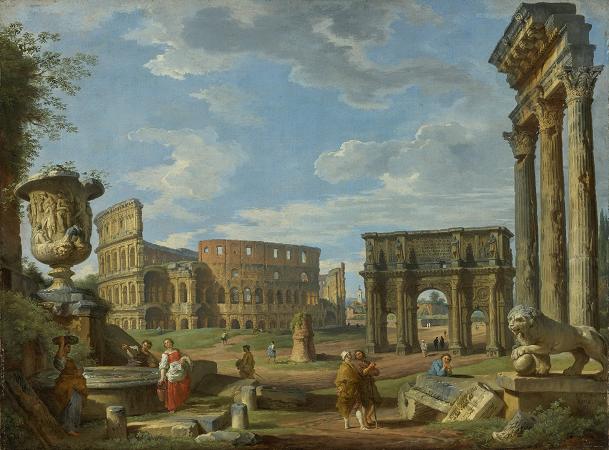Arch of Constantine (c315). The Arch of Constantine is a triumphal arch in Rome, situated between the Colosseum and the Palatine Hill. It was erected by the Roman Senate to commemorate Constantine I's victory over Maxentius at the Battle of Milvian Bridge in 312. Dedicated in 315, it is the largest Roman triumphal arch. The arch spans the Via triumphalis, the way taken by the emperors when they entered the city in triumph. Though dedicated to Constantine, much of the decorative material incorporated earlier work from the time of the emperors Trajan, Hadrian and Marcus Aurelius, and is thus a collage. The last of the existing triumphal arches in Rome, it is also the only one to make extensive use of spolia, reusing several major reliefs from 2nd century imperial monuments, which give a striking and famous stylistic contrast to the sculpture newly created for the arch. This earned it the derisive nickname of Cornacchia di Esopo Aesop's Crow. The arch is 21 m high, 25.9 m wide and 7.4 m deep. It has three archways, the central one being 11.5 m high and 6.5 m wide and the lateral archways 7.4 m by 3.4 m each. Above the archways is placed the attic, composed of brickwork revetted with marble. A staircase within the arch is entered from a door at some height from the ground, on the west side, facing the Palatine Hill. The general design with a main part structured by detached columns and an attic with the main inscription above is modelled after the example of the Arch of Septimius Severus on the Roman Forum. The arch, which was constructed between 312 and 315 AD, was dedicated by the Senate to commemorate ten years of Constantine's reign and his victory over the then reigning emperor Maxentius at the Battle of Milvian Bridge on 28 October 312, as described on its attic inscription, and officially opened on 25 July 315. Not only did the Roman senate give the arch for Constantine's victory, they also were celebrating decennia, a series of games that happens every decade for the Romans. On this occasion they also said many prayers. However, Constantine had actually entered Rome on 29 October 312, amidst great rejoicing, and the Senate then commissioned the monument. Constantine then left Rome within two months and did not return till 326. The location, between the Palatine Hill and the Caelian Hill, spanned the ancient route of Roman triumphs at its origin, where it diverged from the Via sacra. This route was that taken by the emperors when they entered the city in triumph. This route started at the Campus Martius, led through the Circus Maximus, and around the Palatine Hill; immediately after the Arch of Constantine, the procession would turn left at the Meta Sudans and march along the Via sacra to the Forum Romanum and on to the Capitoline Hill, passing through both the Arches of Titus and Septimius Severus. During the Middle Ages, the Arch of Constantine was incorporated into one of the family strongholds of ancient Rome, as shown in the painting by Herman van Swanevelt, here. Works of restoration were first carried out in the 18th century, the last excavations have taken place in the late 1990s, just before the Great Jubilee of 2000. The arch served as the finish line for the marathon athletic event for the 1960 Summer Olympics.
more...














